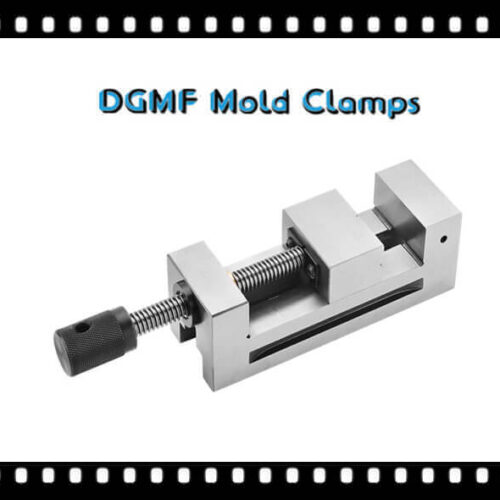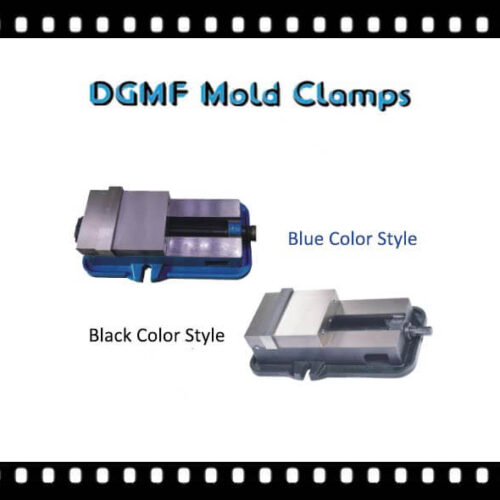Vises
Machine Vises Supplier
DGMF Mold Clamps Co., Ltd is the machine vises supplier, mold clamps supplier, and mould clamps manufacturer in China.
What is vise?
A vise or vice is a mechanical apparatus used to secure an object to allow work to be performed on it. Vises have two parallel jaws, one fixed and the other movable, threaded in and out by a screw and lever.
Vise Types
Woodworker’s vise
“Quick-release” vises
Traditional workbench vises
Face vise
Engineer’s bench vise
A small machine vise used in a drill press
A machine vise that can be rotated
Metalworking vise
Machinist’s vise
Aluminum soft jaw
Machine vises
Miniature vise
Pipe vises
Heavy-duty metalworking vise
Clamp-on vises
Combination vises
Soviet hand vices
Hand vises
Cross vises
Off-center vises
Angle vises
Sine vises
Rotary vises
Suction vices
Diemakers’ vise
Saw vices
Pin vises
Jewelers’ vises
Fly tying vises
Etc
If you cannot find what you are looking for, please contact our engineering/sales team, thank you.
A vise is a tool that uses a screw or other mechanism to make the two jaws move relative to each other to clamp the workpiece. The movable jaws of the machine vise are also driven by pneumatic, hydraulic or eccentric cams for fast clamping.
Features of machine vise
The use of a screw or other mechanisms to make the two jaws for relative movement and clamping workpiece tool. The vise generally consists of a base, vise body, fixed jaws, and movable jaws, as well as the movable jaws to move the transmission mechanism.
According to the use of different occasions, there are different types of vise and machine vise. A jaw vise is mounted on the vise bench for the vise operator to hold the workpiece for sawing, filing, and other processing.
Clamp vise general jaws are high and arched, the vise body can be at the base of any rotation and fastening. A machine vise is a machine tool accessory, also known as a flat vise, generally installed in the milling machine, drilling machine, bullhead planer, and surface grinding machine tools such as the use of the table.
Compared with the vise, machine vise jaws are wide and low, with clamping force, and high precision requirements. There are various types of machine vise, according to the accuracy can be divided into ordinary type and precision type. Precision type for surface grinding machine, boring machine, and other finishing machine tools.
Machine vise according to the structure can also be divided into rotary type with base, fixed type without base, and tilted type. The movable jaws of the machine vise also have pneumatic, hydraulic, or eccentric cams to drive the fast clamping.
How to mount on a milling machine vise?
The vise is supposed to be the most widely used fixture in the world. Highly versatile, affordable, and with a full range of styles and sizes, some of the necessary installation processes are significantly faster as we gain experience with a tool that we deal with regularly.
The installation and straightening work needs to be prepared in advance because in most workshops these things are usually found in different locations.
So in order to work efficiently, you need to find everything beforehand so that when you need to use it, you can easily get it, instead of wasting debugging time on finding tools.
When cleaning the machine, protective gloves are necessary. The chips in the machine are sharp and the coolant can easily cause slippage, so it’s easy to have a safety accident without gloves.
How to adjust a straight CNC vise in the milling machine?
After the tools are ready and the machine table is cleaned up, we start the main event of the day, straightening the vise.
If we are not very, very lucky, we directly put the vise on the machine table is likely to be crooked, which requires us to adjust the position of the vise.
Some vise needs 2 bolts fixed, and some need 4 pressure plates fixed, although fixed in different ways, the principle of adjustment is basically the same.
First, slightly lock the left and right 2 bolts/pressure plates, then loosen one of them.
Next, use the meter to lean on the side where the bolts are locked, move the Y-axis with the handwheel, and after confirming that the ball part of the meter is in contact with the jaws of the vise, adjust the dial of the meter so that the meter pointer points to “0”.
Then shake the hand wheel to move the X-axis, in the process of moving, if you see that the reading is getting bigger and bigger, and it is likely to exceed the travel of the meter, you can move while tapping the vise near the handle with a rubber hammer to adjust the position of the vise.
If the reading is getting smaller and smaller, then don’t worry, you can make adjustments when you move to the other side of the vise.
Repeat the above 2 steps until the calibration meter reads the same on both sides of the jaws.
After locking all the bolts/pressure plates and taking the latter measurement, make sure the vise is still straight after locking.
DGMF Mold Clamps Co., Ltd manufactures the mold clamps and supplies the injection mold components, such as Clamps, Toggle Clamps, C Clamps, Pins, Bushings, Positioning Components, Lock Mold Components, Reset Extrusion, Cavity, and Core Components, Coolings, Die Press Components, Punch And Die, Guide Components, Self-lubricating Components, Springs, Machine Tools, Gate Valves, Machine Mounts, Vises, Fasteners, Lifting, Bolts, Nuts, Washers, etc.
Contact the DGMF Mold Clamps teams for more details about the machine vise, such as specifications, pricing, and inventory.
Showing all 6 results





